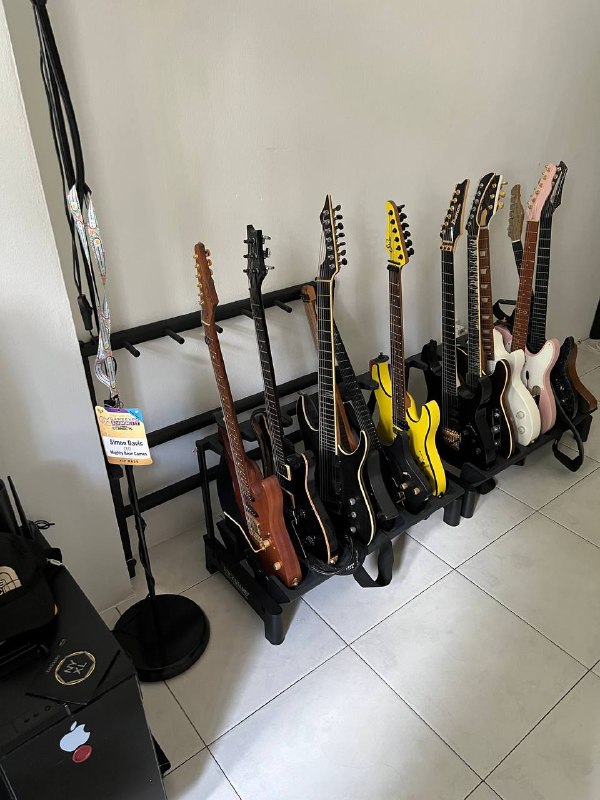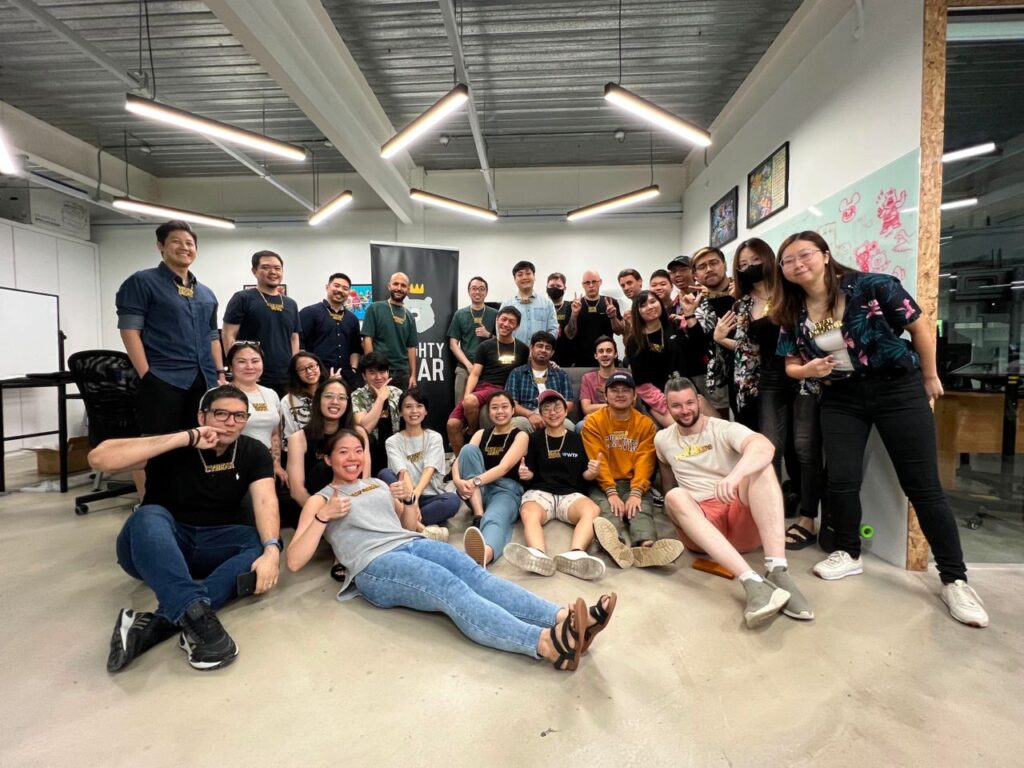Simon Davis is the co-founder and CEO of Mighty Bear Games, a multiplatform game developer in Southeast Asia creating accessible multiplayer experiences in Web3.
Davis has spent almost two decades working in the gaming industry, but he never planned to actually work in this field.
Before crypto, he was a professional guitarist who made ends meet by playing in metal bands and cover bands and by teaching guitar. But after his money dried up one summer, he scored a six-week gig as a professional game tester — and he’s never looked back.

During his time in the gaming industry, Davis has held management and product lead positions at gaming companies including King Digital Entertainment, Ubisoft, Bigpoint, AKQA, Empire Interactive, and Laughing Jackal.
In 2017, Davis teamed up with some friends and fellow industry veterans to launch Mighty Bear Games in Singapore, where they intended to focus on creating traditional games — before pivoting to blockchain in 2022. And in 2023, the firm launched an open beta for Mighty Action Heroes, its first Web3 gaming title.
Davis, who also goes by “Papa Bear,” said every Mighty Bear employee receives a “bear title.” Some of Papa Bear’s employees include “Arty Bear,” “Bear-Abel,” “Excel Bear,” and “Bear McNumbers.”
Why the pivot to blockchain gaming?
I was lucky enough to kind of get into Bitcoin by accident in 2015, so I’ve been in the space for a few years. In 2021, I started playing with NFTs, and I’m lucky enough to be also based in Southeast Asia, so I could see firsthand what was happening with Axie [Infinity]. I think, for me, as someone who lived through the transition to free-to-play, it felt very much like a moment, kind of like when Farmville came out on Facebook.
I think that for live service titles [games like Fortnite, League of Legends and Apex Legends], a dominant business model is going to emerge to revolve around player-owned and operated economies. Because I don’t believe you can have virtual worlds without digital property rights, essentially.
And I think that does enable a lot of new things that we’re really starting to scratch the surface on. So, I think that really was the pull factor.
What format do you think serves as the best way to attract users to blockchain gaming?

I think mobile gaming is going to be the dominant platform because of geography. You see this if you look at the charts for the countries that have a great slope of interest in crypto or Web3. They tend to be countries where existing payment rails are not super developed.
People are largely unbanked in places like Indonesia and Brazil. These markets are mobile-first. Like, people in the Philippines and India are not necessarily using high-end PCs.
So, you need to go where the users are. And this is a bit of a spicy take, but this is why I’m very bearish on people making super HD high-end Web3 games because it’s just not where the markets are today. So, you see a lot of these teams raising, like, mega bucks to make console-quality titles, but if no one can play them, then they aren’t going to do very much.
What do you think the current hurdles are for large-scale blockchain gaming adoption?
A lot of people talk about it in terms of silver bullets, right? Like, “Oh, we need one good game,” or like, “We need to solve the wallet problem.” I don’t think it’s any one of those things. I actually think it is just a lot of lead bullets, a lot of small things that need to happen.
What I’ve experienced today is still pretty terrible, and scary, like social recovery. And it’s starting to become a thing, but that needs to become a lot easier.
Read also
I just think, in general, it needs to be as easy and as brainless to use as a Web2 experience. And so I think there is an inherent conflict today with how people think about Web3, you know. They say things like, “Oh, you need to educate the users,” or, “Train people to hold their private keys.”
But you know, my mom doesn’t want to hold her own private keys. She does all her trading on Crypto.com. We need to make it essentially idiot-proof so anyone can do it.
I think we’re still quite a long way away, but I am seeing meaningful improvements, actually. I’m seeing products that are going to go to market next year which are going to help a lot.
I don’t know how old you are, but I’ve just turned 40 this year. I remember in the 90s setting up a home internet connection on dial-up. It took me two days of calling technical support and someone telling me like configs. I was having to go in and change manually and stuff. And now, you know, we solved that, right? And then, the internet became a mass market, and then people could just put a CD in their computer, and it just worked. I think we need to get to that stage.

Do you think the bad rap blockchain/NFT gaming gets is a big issue?
It’s funny because gaming got a pretty bad rap in the 90s. You know, everyone was talking about how games were making children violent. There was a big moral panic, just like there was in music a few years before.
But I think that when you start to get these things in people’s hands and experience them, perceptions change. I do think a lot of the reputation that we have in crypto and Web3 is deserved. There are a lot of bad actors exploiting the lack of regulation, but the things that excite me: I’ve seen some games, for example, that allow players to earn small amounts of Bitcoin, And this sort of thing’s retention numbers are very strong, like the initial metrics are very promising. And I think that’s a really nice use case.
Reddit is also a great example, right? They put NFTs in the hands of huge numbers of people. A lot of people didn’t even realize they were interacting with NFTs. So then they had their first taste, and yeah — there are some stats that have come up, and not a huge amount of them have transacted on-chain.
But I actually don’t think that’s such a bad thing. If people are not dumping the assets on day one, I don’t see that as a negative. So, I think onboarding through stealth is pretty good.
What kind of adoption metrics are you looking for with your games?
So, people talk about installs and sign-ups — it’s just a vanity metric. For me, I’m interested in how many people are coming in every day, how regularly they’re coming back, and what the growth curve of that looks like initially.
And then once we do the mobile launch [of Mighty Action Heroes], which will be around August/September, how well are we doing on attracting non-crypto-native people into the game as well? That will be very interesting, and to see how they play together. It’s a different angle, but it’s one that I’m pretty bullish on.
What are some ideas or tech upgrades that could help blockchain gaming?
ERC-6551 tokens.
Essentially, they give a smart contract account or a smart contract wallet to a 721 [token]. So, you know, a traditional NFT would be a JPG with some metadata attached. But essentially, the JPG or the asset, whatever that is, is then bound to a smart contract.
And this is pretty cool because it means that assets can communicate directly with each other. So NFT to NFT, without using MetaMask. And it could also be compatible with other smart contract wallets.
I think the really cool thing is that, essentially, your asset becomes a wallet and can have its own logic as well. So you could have a base character in a game as the 6551 token, and then all the clothes or the items or everything that that character has, the kind of sub-assets, can change within, each with its own logic.
As a game developer, you start thinking of how your characters could evolve and how you can attach new assets without updating the core.
Then as a dev, I think it’s really good for reputation management as well. Like, if you did a soulbound version, you could have achievements, proof-of-work, proof-of-play, social identity. I think it’s pretty cool. […] It’s more secure because it’s not just an asset within a wallet like it is on smart contracts with its own private key.
Subscribe
The most engaging reads in blockchain. Delivered once a
week.

Read More: cointelegraph.com










 Bitcoin
Bitcoin  Ethereum
Ethereum  Tether
Tether  XRP
XRP  Solana
Solana  USDC
USDC  Dogecoin
Dogecoin  Cardano
Cardano  TRON
TRON  Lido Staked Ether
Lido Staked Ether  Wrapped Bitcoin
Wrapped Bitcoin  Sui
Sui  Hyperliquid
Hyperliquid  Wrapped stETH
Wrapped stETH  Chainlink
Chainlink  Avalanche
Avalanche  Stellar
Stellar  Shiba Inu
Shiba Inu  Bitcoin Cash
Bitcoin Cash  Hedera
Hedera  LEO Token
LEO Token  Toncoin
Toncoin  Litecoin
Litecoin  Polkadot
Polkadot  WETH
WETH  Monero
Monero  USDS
USDS  Pepe
Pepe  Wrapped eETH
Wrapped eETH  Bitget Token
Bitget Token  Binance Bridged USDT (BNB Smart Chain)
Binance Bridged USDT (BNB Smart Chain)  Pi Network
Pi Network  Ethena USDe
Ethena USDe  Coinbase Wrapped BTC
Coinbase Wrapped BTC  WhiteBIT Coin
WhiteBIT Coin  Bittensor
Bittensor  Uniswap
Uniswap  Aave
Aave  NEAR Protocol
NEAR Protocol  Dai
Dai  Aptos
Aptos  Jito Staked SOL
Jito Staked SOL  Ondo
Ondo  OKB
OKB  Internet Computer
Internet Computer  Cronos
Cronos  Ethereum Classic
Ethereum Classic  BlackRock USD Institutional Digital Liquidity Fund
BlackRock USD Institutional Digital Liquidity Fund